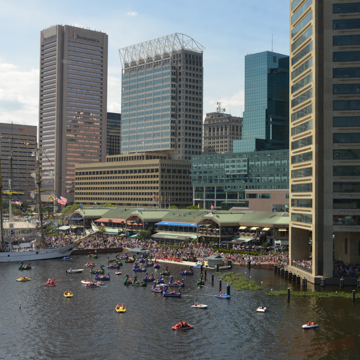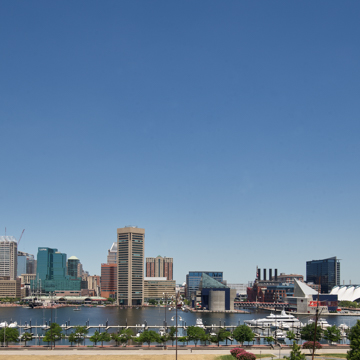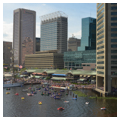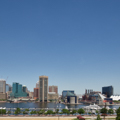The Inner Harbor of Baltimore’s deepwater port on the Patapsco River was transformed in the 1970s and 1980s from a gritty mix of industrial and commercial uses into a tourist and entertainment destination. Postwar proposals for aggressive interstate highway construction would have run a bridge across the Inner Harbor to link I-95 to the Jones Falls Expressway and an East–West Expressway along the north side. Public outcry ensued, and early efforts were launched to reclaim land around the Inner Harbor for public use. The Inner Harbor Master Plan of 1964 was a direct outgrowth of the early success of Charles Center, and its implementation was overseen by a new city agency created in 1965, Charles Center–Inner Harbor Management. Through this mechanism, city planners enforced design guidelines and arranged the massing of buildings around the Inner Harbor to foreground lower, more sculptural structures framed from behind by mid-rise buildings and tall towers. By the 1970s parks, a brick promenade along the water, and a few key commercial projects such as the United States Fidelity and Guaranty (USF&G) Life Insurance Company’s forty-story tower (now the Transamerica Tower) and the World Trade Center were in place.
The original idea was to reclaim the waterfront for Baltimore residents—few people conceived that Baltimore could attract large numbers of visitors. Attitudes began to change with the popularity of the visiting tall ships during the 1976 Bicentennial celebration and the opening of the Maryland Science Center (1971–1975, Edward Durell Stone; 601 Light Street). Also important was the docking of the 1854 sloop-of-war the USS Constellation as a permanent attraction, thought to be the original 1797 frigate with modifications. However, it was developer James Rouse’s controversial Harborplace festival market-place project that provided a catalyst for the final transformation of the Inner Harbor into a tourist destination. The National Aquarium and Baltimore Hyatt Regency (A. Epstein and Sons and RTKL Associates; 300 Light) followed shortly thereafter, both opening in 1981.
Today predominately late-twentieth-century construction around the Inner Harbor is accompanied by a few historic survivors. Maritime history is represented by the USS Constellation and other attractions managed by Historic Ships of Baltimore, including the Seven Foot Knoll Lighthouse (1855). Relocated to Pier 5 from the mouth of the Patapsco River in 1988, it is a screw-pile lighthouse typical of the Chesapeake Bay. Another nod to the history of the Inner Harbor includes preservation of the Pratt Street Power Plant (1900–1909, Baldwin and Pennington; 601 E. Pratt Street) as a mixed-use project. Standing in dramatic contrast across the slip on Pier 5, the tent-like fiberglass-reinforced Teflon roof of the Columbus Center (1995, Eberhard Zeidler; 701 E. Pratt) houses event space and a technology incubator now owned by the University System of Maryland. A small glass-walled pavilion with a swooping roofline was added to the park on the west edge of the Inner Harbor in 2004, bringing the architectural ensemble up to the twenty-first century and serving tourists as the Baltimore Visitor Center (2004, Design Collective; 401 Light).
More recent development of hotels and other commercial structures to the east is a testament to the Inner Harbor’s continued success as a tourist and convention draw. The transformation of a working harbor into an entertainment district signaled the reinvention of Baltimore to a regional and national audience while, for better or worse, embodying shifts from production to consumption as a catalyst for the American economy.
References
Billing, JC. “Baltimore Past Harbors Its Future-Maryland Seaport Transformation.” Landscape Architecture 77, no. 5 (1987): 68-73.
Brambilla, Roberto. Learning from Baltimore: what makes cities liveable? New York: Institute for Environmental Action, 1979.
Canty, D. “Baltimore Lively Downtown Lagoon Inner-Harbor Plan.” Journal of the American Institute Of Architects 70, no. 7 (1981): 33-42.
Clay, G. “On Baltimore Inner Harbor.” Landscape Architecture 72, no. 6 (1982): 48-53.
Dilts, James D. The Great Road: The Building of the Baltimore and Ohio, the Nation's First Railroad, 1828–1853. Stanford University Press, 1996.
Falk, Nicholas. “Baltimore and Lowell: Two American Approaches.” Built Environment 12, no. 3 (1986): 145–152.
Gillette, Howard. “Assessing James Rouse’s role in American city planning.” Journal of the American Planning Association 65, no. 2 (1999): 150-167.
Gunts, Edward. “He helped bring humanity back to the city: Benjamin Thompson, the designer of Harborplace, knew the role of buildings Architecture.” Baltimore Sun, August 25, 2002.
Gunts, Edward. “Why McKeldin Fountain was built – and what’s being planned in its place.” Baltimore Brew, July 24, 2015.
Hudson, Kris. “General Growth Sells Baltimore Mall.” Wall Street Journal, October 24, 2012.
Ingram, Callum. “Building between past and future: Nostalgia, historical materialism and the architecture of memory in Baltimore’s Inner Harbor.” Philosophy and Social Criticism 41, no. 3 (2015): 317-333.
Kelley, Brian, and Roger K. Lewis. “What’s right (and wrong) about Inner Harbor: A 1990s take on Baltimore’s massive downtown revitalization project.” Planning 58, no. 4 (1992): 28.
Krempasky, Laura. “Leave It Better: A Recreation Renaissance.” Parks and Recreation 42, no. 5 (2007): 14.
Levine, Marc V. “A Third-world City in the First World: Social Exclusion, Racial Inequality, and Sustainable Development in Baltimore, Maryland.” In The Social Sustainability of Cities: Diversity and the Management of Change. Edited by Mario Polèse And Richard Stren, 123–156. Toronto: University of Toronto Press, 2000.
Millspaugh, Martin L. “The Inner Harbor story: a model of urban waterfront development, Baltimore’s Inner Harbor offers an adventure in downtown revitalization.” Urban Land 62, no. 4 (2003): 36.
Mountford, Kent. “Ghosts of industrial heyday still haunt Baltimore’s harbor, creeks.” Bay Journal, May 1, 1999.
Norvell, Scott. “Exploring Baltimore’s Inner Harbor.” New York Times, April 20, 2001.
Sherman, Natalie. “Harborplace Owners Move Forward with Plans to Improve Pavilions.” McClatchy – Tribune Business News (Washington), May 24, 2014.
Walker, Andrea. “Harborplace up for Sale: Nearly $3.1 Billion in Debt, General Growth Properties Plans to Sell Baltimore’s Harborplace & The Gallery to Avoid Bankruptcy.” McClatchy – Tribune Business News (Washington), December 19, 2008.
Wallace, David. “Planning My Way: Longtime consultant David Wallace, AICP, tells it as it was in Urban Planning.” Planning 70, no. 2 (2004): 44.
Waterfront Partnership of Baltimore, Inc. Baltimore Inner Harbor 2.0. Baltimore: City of Baltimore, 2013.





